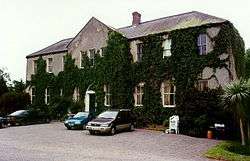John Cornwalsh
Sir John Cornwalsh (died 1472) was an Irish judge who held the office of Chief Baron of the Irish Exchequer. His tenure was notable for the fact that he succeeded his father as Chief Baron, and for his long struggle to retain the office against a rival claimant, Michael Gryffin.
Background
He was probably born at Dunboyne in County Meath, and he later lived at Dardistown in the same county. He was the son of James Cornwalsh and Matilda Rochfort; the Cornwalsh family were originally from Cornwall. His father was Chief Baron of the Exchequer, with intervals, from 1420 to 1441, when he was murdered by the Fitzwlliam family. John followed his father into the legal profession and went to London to study law; he was living at Tower Hill in 1434.[1] He is next heard of "fighting the King's enemies in Ossory" in 1441.[2] In September of that year his father was murdered at the instigation of William Fitzwilliam and his wife Ismay, in a feud over the possession of Baggotrath Castle near Dublin. The fact that Fitzwilliam and Ismay received a royal pardon for the crime gives us a vivid glimpse of the lawless condition of Ireland at the time (although it must be said that the condition of England, under the inept rule of King Henry VI, was not much better).
Career
He was appointed Chief Baron soon after his father's death, probably on the advice of the powerful Anglo-Irish magnate James Butler, 4th Earl of Ormond, who had been a close associate of his father. However a few weeks later a patent was issued in London appointing Michael Gryffin to the same office.[3] For five years Gryffin's supporters contrived to keep Cornwalsh out of office; finally in 1446 he obtained a declaration that his rival's letters patent had been obtained illegally.[4]
This conflict reflected the wider political divisions of the time, but Elrington Ball suggests that there were also valid objections to Cornwalsh's appointment as a judge.[5] Despite his being the son of a long-serving jurist and despite his having studied law at the Inns of Court, his legal knowledge was thought to be insufficient to become a judge, although in his defence it may be said that his rival Gryffin apparently had no legal training at all. In addition Cornwalsh was a turbulent and unpopular individual: in the 1450s he quarreled with the Duke of York, the Lord Lieutenant of Ireland, and with his Privy Council, and was accused of inciting the citizens of Dublin to rebellion.[6] During York's final Irish Parliament in 1460, Cornwalsh was one of his few opponents, and an Act of Resumption, declaring his estates liable to forfeiture, was passed.[7] After York's death at the Battle of Wakefield no further action seems to have been taken against Cornwalsh, despite the triumph of York's son King Edward IV, the following year. Edward was generally inclined to seek reconciliation with his former opponents: Cornwalsh remained in office until his death in 1472, and he was knighted around 1466.
Family
He married in 1444 Maud (or Matilda) Plunkett, widow of Richard Talbot of Malahide Castle, and also widow of Thomas Hussey, 5th Baron Galtrim, who was murdered on their wedding day, thus inspiring the nineteenth-century ballad "The Bride of Malahide".[8] She was the daughter of Christopher Plunkett, first Baron Killeen. She died in 1482.[9]
Cornwalsh built Dardistown Castle, County Meath, in about 1465, and had possession of Malahide Castle and the Galtrim estates (roughly modern Summerhill, County Meath) for his lifetime in right of his wife. He had no children, and his estates passed to his stepson Thomas Talbot.

References
- Ball, F. Elrington The Judges in Ireland 1221-1921 London John Murray 1926 Vol.1 p.178
- Ball, p.178
- Ball, p.101
- Griffiths, Ralph A. The Reign of Henry VI-the exercise of Royal Authority Ernest Benn Ltd. 1981 p.417
- Ball, p.101
- Ball, p.101
- Otway-Ruthven, A.J. A History of Mediaeval Ireland Barnes and Noble 1993 pp. 387-8
- Burke's Peerage 4th Edition London 1833 Vol. 2 p.522
- Burke's Peerage p.522